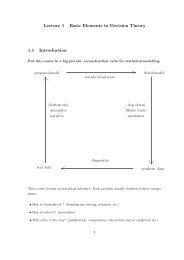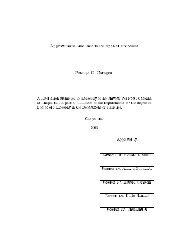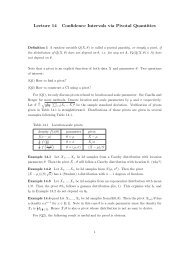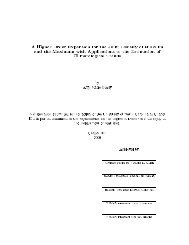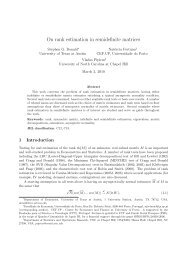Monte Carlo Methods in Statistical Mechanics: Foundations and ...
Monte Carlo Methods in Statistical Mechanics: Foundations and ...
Monte Carlo Methods in Statistical Mechanics: Foundations and ...
Create successful ePaper yourself
Turn your PDF publications into a flip-book with our unique Google optimized e-Paper software.
solution is reached <strong>in</strong> a very few MG iterations (<strong>in</strong> particular, critical slow<strong>in</strong>g-down is<br />
completely elim<strong>in</strong>ated). This viewpo<strong>in</strong>t also expla<strong>in</strong>s why MG convergence is more delicate<br />
for piecewise-constant <strong>in</strong>terpolation than for piecewise-l<strong>in</strong>ear: the po<strong>in</strong>t isthat a<br />
s<strong>in</strong>e wave (orother slowly vary<strong>in</strong>g function) can be approximated to arbitrary accuracy<br />
(<strong>in</strong> energy norm) by piecewise-l<strong>in</strong>ear functions but not by piecewise-constant functions.<br />
We remark that McCormick <strong>and</strong>Ruge [39] have advocated the \unigrid" idea not<br />
just as an alternate po<strong>in</strong>t of view on the multi-grid algorithm, but asanalternate computational<br />
procedure. To be sure, the unigrid method is somewhat simpler to program,<br />
<strong>and</strong> this could have pedagogical advantages. But oneofthe key properties of the multigrid<br />
method, namely the O(L d ) computational labor per iteration, is sacri ced <strong>in</strong> the<br />
unigrid scheme. Instead of (5.33){(5.34) one has<br />
<strong>and</strong> hence<br />
work(UG) WM<br />
l=M<br />
Wl WM (5.36)<br />
0X<br />
M;l<br />
MWM if =1<br />
M WM if >1<br />
S<strong>in</strong>ce M log2 L <strong>and</strong> WM Ld ,weobta<strong>in</strong><br />
(<br />
d L log L if =1<br />
work(UG)<br />
Ld+log2 if >1<br />
(5.37)<br />
(5.38)<br />
For a V-cycle the additional factor of log L is perhaps not terribly harmful, but for a<br />
W-cycle the additional factor of L is a severe drawback (though not as severe as the<br />
O(L 2 )critical slow<strong>in</strong>g-down of the traditional algorithms). Thus, we donot advocate<br />
the use of unigrid as a computational method if there is a viable multi-grid alternative.<br />
Unigrid could, however, be of <strong>in</strong>terest <strong>in</strong> cases where true multi-grid is unfeasible, as<br />
may occur for non-Abelian lattice gauge theories.<br />
Multi-grid algorithms can also be devised for some models <strong>in</strong> which state space is a<br />
nonl<strong>in</strong>ear manifold, such as nonl<strong>in</strong>ear -models <strong>and</strong> lattice gauge theories [20, Sections<br />
3{5]. The simplest case is the XY model: both the ne-grid <strong>and</strong> coarse-grid eld<br />
variables are angles, <strong>and</strong>the <strong>in</strong>terpolation operator is piecewise-constant (withangles<br />
added modulo 2 ). Thus, a coarse-grid variable y speci es the angle by whichthe<br />
2 d sp<strong>in</strong>s <strong>in</strong> the block By are to besimultaneously rotated. A similar strategy can be<br />
employed for nonl<strong>in</strong>ear -models tak<strong>in</strong>g values <strong>in</strong> a group G (the so-called \pr<strong>in</strong>cipal<br />
chiral models"): the coarse-grid variable y simultaneously left-multiplies the2 d sp<strong>in</strong>s <strong>in</strong><br />
the block By. For nonl<strong>in</strong>ear -models tak<strong>in</strong>g values <strong>in</strong> a nonl<strong>in</strong>ear manifold M on which<br />
a group G acts [e.g. the n-vector model with M = Sn;1 <strong>and</strong> G = SO(n)], the coarsegrid-correction<br />
moves are still simultaneous rotation this means that while the ne-grid<br />
37



